Abstract
Killer toxin resistant 6 (Kre6) and its paralog, suppressor of Kre null 1 (Skn1), are thought to be involved in the biosynthesis of cell wall β-(1 → 6)-D-glucan in baker’s yeast, Saccharomyces cerevisiae. The Δkre6Δskn1 mutant of S. cerevisiae and other fungi shows severe growth defects due to the failure to synthesize normal cell walls. In this study, two homologs of Kre6, namely, K6LP1 (Kre6-like protein 1) and K6LP2 (Kre6-like protein 2), were identified in Aureobasidium pullulans M-2 by draft genome analysis. The Δk6lp1, Δk6lp2, and Δk6lp1Δk6lp2 mutants were generated in order to confirm the functions of the Kre6-like proteins in A. pullulans M-2. The cell morphologies of Δk6lp1 and Δk6lp1Δk6lp2 appeared to be different from those of wild type and Δk6lp2 in both their yeast and hyphal forms. The productivity of the extracellular polysaccharides, mainly composed of β-(1 → 3),(1 → 6)-D-glucan (β-glucan), of the mutants was 5.1–17.3% less than that of wild type, and the degree of branching in the extracellular β-glucan of mutants was 14.5–16.8% lower than that of wild type. This study showed that the gene disruption of Kre6-like proteins affected the cell morphology, the productivity of extracellular polysaccharides, and the structure of extracellular β-glucan, but it did not have a definite effect on the cell viability even in Δk6lp1Δk6lp2, unlike in the Δkre6Δskn1 of S. cerevisiae.
This is a preview of subscription content, log in via an institution to check access.
Similar content being viewed by others

CreA is directly involved in pullulan biosynthesis and regulation of Aureobasidium melanogenum P16
Article 15 September 2016

Improved production of β-glucan by a T-DNA–based mutant of Aureobasidium pullulans
Article 27 August 2021

Enhanced β-glucan and pullulan production by Aureobasidium pullulans with zinc sulfate supplementation
Article 23 December 2019
Explore related subjects
Discover the latest articles, books and news in related subjects, suggested using machine learning.
- Cell wall
- Cytoskeletal proteins
- Fungal biology
- Fungal Genes
- Fungal genetics
- Saccharomyces cerevisiae
References
- Aimanianda V, Simenel C, Garnaud C, Clavaud C, Tada R, Barbin L, Mouyna I, Heddergott C, Popolo L, Ohya Y, Delepierre M, Latge JP (2017) The dual activity responsible for the elongation and branching of β-(1,3)-glucan in the fungal cell wall. mBio 8:e00619–e00617. https://doi.org/10.1128/mBio.00619-17Article PubMed PubMed Central CAS Google Scholar
- Aoki S, Iwai A, Kawata K, Muramatsu D, Uchiyama H, Okabe M, Ikesue M, Maeda N, Uede T (2015a) Oral administration of the Aureobasidium pullulans-derived β-glucan effectively prevents the development of high fat diet-induced fatty liver in mice. Sci Rep 5:10457. https://doi.org/10.1038/srep10457Article PubMed PubMed Central CAS Google Scholar
- Aoki S, Iwai A, Kawata K, Muramatsu D, Uchiyama H, Okabe M, Ikesue M, Maeda N, Uede T (2015b) Oral administration of the β-glucan produced by Aureobasidium pullulans ameliorates development of atherosclerosis in apolipoprotein E deficient mice. J Funct Foods 18:22–27. https://doi.org/10.1016/j.jff.2015.06.044Article CAS Google Scholar
- Arellano M, Durán A, Pérez P (1996) Rhol GTPase activates the (1-3)β-D-glucan synthase and is involved in Schizosaccharomyces pombe morphogenesis. EMBO J 15:4584–4591. https://doi.org/10.1002/j.1460-2075.1996.tb00836.xArticle PubMed PubMed Central CAS Google Scholar
- Bankevich A, Nurk S, Antipov D, Gurevich AA, Dvorkin M, Kulikov AS, Lesin VM, Nikolenko SI, Pham S, Prjibelski AD, Pyshkin AV, Sirotkin AV, Vyahhi N, Tesler G, Alekseyev MA, Pevzner PA (2012) SPAdes: a new genome assembly algorithm and its applications to single-cell sequencing. J Comput Biol 19:455–477. https://doi.org/10.1089/cmb.2012.0021Article PubMed PubMed Central CAS Google Scholar
- Bolger AM, Lohse M, Usadel B (2014) Trimmomatic: a flexible trimmer for Illumina sequence data. Bioinformatics 30:2114–2120. https://doi.org/10.1093/bioinformatics/btu170Article PubMed PubMed Central CAS Google Scholar
- Chaung HC, Huang TC, Yu JH, Wu ML, Chung WB (2009) Immunomodulatory effects of β-glucans on porcine alveolar macrophages and bone marrow haematopoietic cell-derived dendritic cells. Vet Immunol Immunopathol 131:147–157. https://doi.org/10.1016/j.vetimm.2009.04.004Article PubMed CAS Google Scholar
- De Backer MD, Maes D, Vandoninck S, Logghe M, Contreras R, Luyten WH (1999) Transformation of Candida albicans by electroporation. Yeast 15:1609–1618. https://doi.org/10.1002/(SICI)1097-0061(199911)15:15<1609::AID-YEA485>3.0.CO;2-YArticle PubMed Google Scholar
- Douglas CM, Foor F, Marrinan JA, Morin N, Nielsen JB, Dahl AM, Mazur P, Baginsky W, Li W, el-Sherbeini M, Clemas JA, Mandala SM, Frommer BR, Kurtz MB (1994) The Saccharomyces cerevisiae FKS1 (ETG1) gene encodes an integral membrane protein which is a subunit of 1,3-β-D-glucan synthase. Proc Natl Acad Sci U S A 91:12907–12911
- Du B, Lin C, Bian Z, Xu B (2015) An insight into anti-inflammatory effects of fungal beta-glucans. Trends Food Sci Technol 41:49–59. https://doi.org/10.1016/j.tifs.2014.09.002Article CAS Google Scholar
- Dubois M, Gilles KA, Hamilton JK, Rebers PA, Smith F (1956) Colorimetric method for determination of sugars and related substances. Anal Chem 28:350–356. https://doi.org/10.1021/ac60111a017Article CAS Google Scholar
- Gilbert NM, Donlin MJ, Gerik KJ, Specht CA, Djordjevic JT, Wilson CF, Sorrell TC, Lodge JK (2010) KRE genes are required for β-1,6-glucan synthesis, maintenance of capsule architecture and cell wall protein anchoring in Cryptococcus neoformans. Mol Microbiol 76:517–534. https://doi.org/10.1111/j.1365-2958.2010.07119.xArticle PubMed PubMed Central CAS Google Scholar
- Hakomori S (1964) A rapid permethylation of glycolipid, and polysaccharide catalyzed by methylsulfinyl carbanion in dimethyl sulfoxide. J Biochem 55:205–208PubMed CAS Google Scholar
- Huang W, Bártulos RC, Kroth PG (2016) Diatom vacuolar 1,6-β-transglycosylases can functionally complement the respective yeast mutants. J Eukaryot Microbiol 63:536–546. https://doi.org/10.1111/jeu.12298Article PubMed CAS Google Scholar
- Jesenak M, Majtan J, Rennerova Z, Kyselovic J, Banovcin P, Hrubisko M (2013) Immunomodulatory effect of pleuran (β-glucan from Pleurotus ostreatus) in children with recurrent respiratory tract infections. Int Immunopharmacol 15:395–399. https://doi.org/10.1016/j.intimp.2012.11.020Article PubMed CAS Google Scholar
- Kawata K, Iwai A, Muramatsu D, Aoki S, Uchiyama H, Okabe M, Hayakawa S, Takaoka A, Miyazaki T (2015) Stimulation of macrophages with the β-glucan produced by Aureobasidium pullulans promotes the secretion of tumor necrosis factor-related apoptosis inducing ligand (TRAIL). PLoS One 10:e0124809. https://doi.org/10.1371/journal.pone.0124809Article PubMed PubMed Central CAS Google Scholar
- Kim YT, Kim EH, Cheong C, Williams DL, Kim CW, Lim ST (2000) Structural characterization of β-D-(1→3, 1→6)-linked glucans using NMR spectroscopy. Carbohydr Res 328:331–341. https://doi.org/10.1016/S0008-6215(00)00105-1Article PubMed CAS Google Scholar
- Komatsu N, Okubo S, Kikumoto S, Kimura K, Saito G (1969) Host-mediated antitumor action of schizophyllan, a glucan produced by Schizophyllum commune. Gan 60:137–144. https://doi.org/10.20772/cancersci1959.60.2_137Article PubMed CAS Google Scholar
- Kurita T, Noda Y, Takagi T, Osumi M, Yoda K (2011) Kre6 protein essential for yeast cell wall β-1,6-glucan synthesis accumulates at sites of polarized growth. J Biol Chem 286:7429–7438. https://doi.org/10.1074/jbc.M110.174060Article PubMed CAS Google Scholar
- Liu J, Gunn L, Hansen R, Yan J (2009) Yeast-derived β-glucan in combination with anti-tumor monoclonal antibody therapy in cancer. Recent Pat Anti Cancer Drug Discov 4:101–109. https://doi.org/10.2174/157489209788452858Article CAS Google Scholar
- Mio T, Yamada-Okabe T, Yabe T, Nakajima T, Arisawa M, Yamada-Okabe H (1997) Isolation of the Candida albicans homologs of Saccharomyces cerevisiae KRE6 and SKN1: expression and physiological function. J Bacteriol 179:2363–2372Article PubMed PubMed Central CAS Google Scholar
- Moriya N, Moriya Y, Nomura H, Kusano K, Asada Y, Uchiyama H, Park EY, Okabe M (2013) Improved β-glucan yield using an Aureobasidium pullulans M-2 mutant strain in a 200-L pilot scale fermentor targeting industrial mass production. Biotechnol Bioprocess Eng 18:1083–1089. https://doi.org/10.1007/s12257-013-0516-9Article CAS Google Scholar
- Muramatsu D, Iwai A, Aoki S, Uchiyama H, Kawata K, Nakayama Y, Nikawa Y, Kusano K, Okabe M, Miyazaki T (2012) β-glucan derived from Aureobasidium pullulans is effective for the prevention of influenza in mice. PloS One 7:e41399. https://doi.org/10.1371/journal.pone.0041399Article PubMed PubMed Central CAS Google Scholar
- Muramatsu D, Kawata K, Aoki S, Uchiyama H, Okabe M, Miyazaki T, Kida H, Iwai A (2014) Stimulation with the Aureobasidium pullulans-produced β-glucan effectively induces interferon stimulated genes in macrophage-like cell lines. Sci Rep 4:4777. https://doi.org/10.1038/srep04777Article PubMed PubMed Central CAS Google Scholar
- Roemer T, Delaney S, Bussey H (1993) SKN1 and KRE6 define a pair of functional homologs encoding putative membrane proteins involved in β-glucan synthesis. Mol Cell Biol 13:4039–4048. https://doi.org/10.1128/MCB.13.7.4039Article PubMed PubMed Central CAS Google Scholar
- Shimizu K, Watanabe S, Watanabe S, Matsuda K, Suga T, Nakazawa S, Shiratori K (2009) Efficacy of oral administered superfine dispersed lentinan for advanced pancreatic cancer. Hepato-Gastroenterology 56:240–244PubMed CAS Google Scholar
- Singh PP, Whistler RL, Tokuzen R, Nakahara W (1974) Scleroglucan, an antitumor polysaccharide from Sclerotium glucanicum. Carbohydr Res 37:245–247. https://doi.org/10.1016/S0008-6215(00)87078-0Article PubMed CAS Google Scholar
- Teparić R, Mrša V (2013) Proteins involved in building, maintaining and remodeling of yeast cell walls. Curr Genet 59:171–185. https://doi.org/10.1007/s00294-013-0403-0Article PubMed CAS Google Scholar
- Thompson JR, Register E, Curotto J, Kurtz M, Kelly R (1998) An improved protocol for the preparation of yeast cells for transformation by electroporation. Yeast 14:565–571. https://doi.org/10.1002/(SICI)1097-0061(19980430)14:6<565::AID-YEA251>3.0.CO;2-BArticle PubMed CAS Google Scholar
- Thornewell SJ, Peery RB, Skatrud PL (1995a) Cloning and characterization of the gene encoding translation elongation factor 1α from Aureobasidium pullulans. Gene 162:105–110. https://doi.org/10.1016/0378-1119(95)00312-TArticle PubMed CAS Google Scholar
- Thornewell SJ, Peery RB, Skatrud PL (1995b) Integrative and replicative genetic transformation of Aureobasidium pullulans. Curr Genet 29:66–72. https://doi.org/10.1007/BF00313195Article PubMed CAS Google Scholar
- Xu H, Zou S, Xu X, Zhang L (2016) Anti-tumor effect of β-glucan from Lentinus edodes and the underlying mechanism. Sci Rep 6:28802. https://doi.org/10.1038/srep28802Article PubMed PubMed Central CAS Google Scholar
- Yoon TJ, Kim TJ, Lee H, Shin KS, Yun YP, Moon WK, Kim DW, Lee KH (2008) Anti-tumor metastatic activity of β-glucan purified from mutated Saccharomyces cerevisiae. Int Immunopharmacol 8:36–42. https://doi.org/10.1016/j.intimp.2007.10.005Article PubMed CAS Google Scholar
- Zhou LD, Zhang QH, Zhang Y, Liu J, Cao YM (2009) The shiitake mushroom-derived immuno-stimulant lentinan protects against murine malaria blood-stage infection by evoking adaptive immune-responses. Int Immunopharmacol 9:455–462. https://doi.org/10.1016/j.intimp.2009.01.010Article PubMed CAS Google Scholar
Author information
Authors and Affiliations
- Laboratory of Biotechnology, Integrated Bioscience Section, Graduate School of Science and Technology, Shizuoka University, 836 Ohya, Suruga-ku, Shizuoka, 422-8529, JapanHirofumi Uchiyama, Tatsuya Kato & Enoch Y. Park
- Aureo-Science Co., Ltd., Nishi 12-2, Kita 21-jo, Kita-ku, Sapporo, Hokkaido, 001-0021, JapanHirofumi Uchiyama & Atsushi Iwai
- Instrumental Research Support Office, Research Institute of Green Science and Technology, Shizuoka University, 836 Ohya, Suruga-ku, Shizuoka, 422-8529, JapanHideo Dohra
- Laboratory of Organic Chemistry of Natural Products, Green Chemistry Research Division, Research Institute of Green Science and Technology, Shizuoka University, 836 Ohya, Suruga-ku, Shizuoka, 422-8529, JapanToshiyuki Ohnishi
- Laboratory of Biotechnology, Green Chemistry Research Division, Research Institute of Green Science and Technology, Shizuoka University, 836 Ohya, Suruga-ku, Shizuoka, 422-8529, JapanTatsuya Kato & Enoch Y. Park
References
